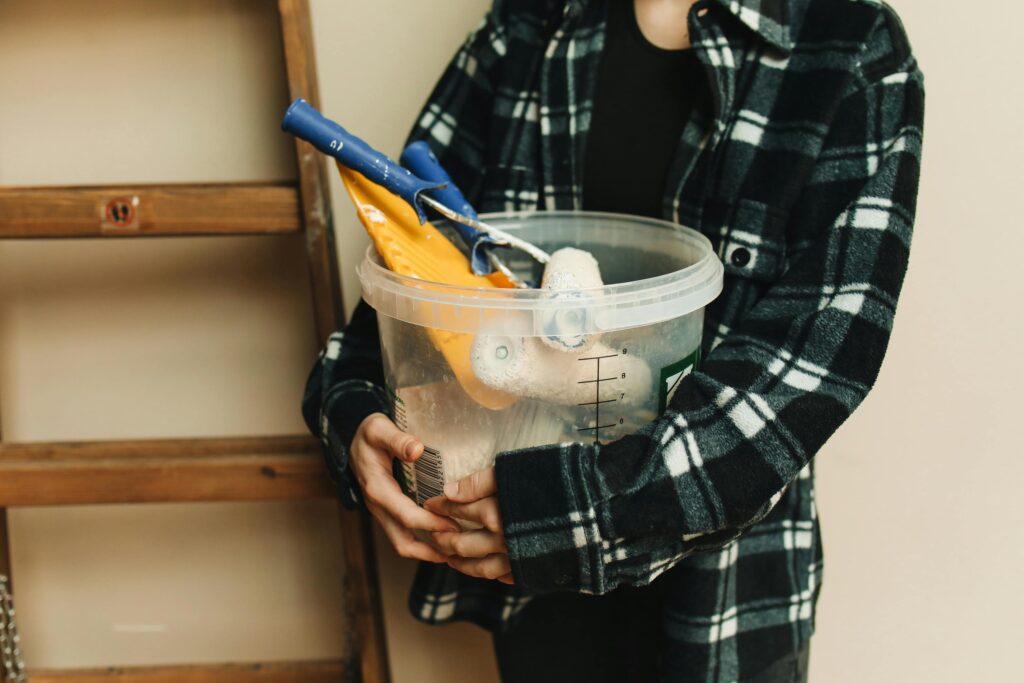In this article, you’ll discover how to create a budget that balances your vision with your wallet. We’ll guide you step-by-step through assessing your needs, estimating material and labor costs, and prioritizing expenses without compromising quality. By the end, you’ll have the confidence to manage your painting project efficiently, avoiding unexpected expenses while achieving stunning results. Ready to transform your home with a financially savvy approach? Let’s dive into building the perfect budget for your residential painting project.
Table of Contents
ToggleKey Takeaways
- Define Your Project Scope: Clearly outline which areas you’ll paint and the finishes you want before budgeting begins.
- Research Material & Labor Costs: Compare multiple quotes for paint quality and professional labor to find the best value.
- Allocate a Contingency Fund: Set aside 10–15% of your total budget for unexpected repairs or additional coats.
- Prioritize Quality: Investing in premium paint and proper surface prep reduces maintenance costs and enhances longevity.
- Track Every Expense: Use a spreadsheet or app to log all purchases and labor payments, enabling real-time budget adjustments.
- Timing Matters: Schedule your painting during off-peak seasons or weekdays when contractors may offer discounted rates.
- DIY Where Feasible: Take on simple prep tasks yourself—like cleaning and taping—to save on labor costs without sacrificing results.
- Communicate Clearly: Keep contractors informed about budget limits and project priorities to avoid surprises and ensure alignment.
Why a Smart Budget for Your Residential Painting Project Is More Important Than You Think
When embarking on a residential painting project, one of the most crucial steps is creating a smart budget. But what exactly does that mean? A smart budget goes beyond simply estimating the cost of paint and labor; it includes careful planning, anticipating unexpected expenses, and ensuring that every dollar spent maximizes value and quality. Understanding and implementing a smart budget for your residential painting project can save you time, money, and stress in the long run.
The importance of a smart budget cannot be overstated. According to a survey by HomeAdvisor, the average cost to paint a home interior ranges from $1,500 to $3,000, but many homeowners underestimate the total expenses involved. Without a well-thought-out budget, projects can quickly go over cost or suffer from poor quality due to cutting corners.
A smart budget empowers homeowners to make informed decisions. For example, instead of choosing the cheapest paint, they can opt for premium-quality products that offer better durability and finish, resulting in a longer-lasting paint job. Additionally, having a clear budget helps prevent last-minute financial surprises. Unexpected costs such as repairing wall damage, removing old paint, or addressing mold issues often arise, and a buffer in your budget for such contingencies can make the difference between a smooth renovation and a stressful ordeal.
Consider the story of Sarah, a homeowner in Austin, Texas, who initially planned to paint her two-story house on a tight budget. By creating a detailed smart budget, she accounted for paint, professional labor, prep work, and contingencies like priming walls with mold-prone areas. Thanks to her foresight, Sarah avoided costly delays and was able to complete the project within budget, while achieving a vibrant and lasting finish that increased her home’s value.
In summary, a smart budget for your residential painting project is not just a financial plan but a foundation for a successful home improvement experience. It ensures quality, prevents overspending, and helps you turn your vision into reality with confidence.
Next, let’s explore how to build this budget step-by-step to fully harness its benefits.
How to Apply a Smart Budget for Your Residential Painting Project Step by Step
Embarking on a residential painting project can be exciting yet overwhelming, especially when it comes to managing your finances. A smart budget is your best ally to deliver a beautiful paint job without breaking the bank. Here’s a detailed, step-by-step guide to help you create and apply a smart budget for your residential painting project, ensuring cost-efficiency and high-quality results.
Step 1: Define the Scope of Your Painting Project
Before allocating any funds, clearly identify the scope of your painting project. Are you painting just the interior walls, the exterior, or both? Consider:
– Number of rooms or exterior surfaces.
– Condition of walls (e.g., presence of cracks or peeling paint).
– Types of finishes (matte, glossy, semi-gloss).
– Additional services such as priming or wallpaper removal.
Creating a detailed list helps to eliminate surprises and allows for accurate budget planning.
Step 2: Research and List Material Costs
Materials typically represent a significant portion of your painting budget. To be smart about your budget:
– List down all required materials: paint, primer, brushes, rollers, drop cloths, painter’s tape, ladders, and safety gear.
– Choose quality paint that fits your needs but avoid unnecessary over-specifications.
– Compare prices from different suppliers or stores.
– Factor in potential wastage, calculate approximately 10% extra paint for touch-ups.
Example:
If painting a 10’ x 12’ room with two coats requires about 2 gallons of paint, and each gallon costs $30, your paint cost for that room would be $60 plus an additional $6 (10% extra).
Step 3: Estimate Labor Costs or Identify DIY Potential
Labor can make or break your budget. Decide whether to hire professional painters or do it yourself:
– Hiring professionals: Obtain at least three detailed quotes. Ensure they include labor, materials, and cleanup.
– DIY: Calculate hours required and factor in your time’s value. Also, account for any equipment rentals.
Step 4: Allocate a Contingency Fund
No project goes entirely as planned. Reserve about 10%–15% of your total budget for unforeseen expenses, such as:
– Repairing unexpected wall damage.
– Additional coats of paint due to color changes.
– Last-minute supply needs.
Step 5: Track and Monitor Expenses
Use a simple spreadsheet or budget app to track every expense against your initial estimates. Record:
– Pre-project estimates.
– Actual costs as they occur.
– Payment dates and balances.
This proactive monitoring will help you stay within budget and adjust if necessary.
Bonus Tips for a Smart Budget:
– Opt for quality over the cheapest materials. Superior paint may reduce the number of coats and last longer, saving money over time.
– Consider the timing of your project. Off-season painting jobs might cost less if hiring professionals.
– Plan for maintenance. Budget future touch-ups to prolong your paint’s lifespan and avoid costly re-paints.
By following these steps and staying organized, applying a smart budget for your residential painting project becomes a stress-free process, allowing you to enjoy the transformation without financial headaches. With careful planning, resourceful decision-making, and a detailed budget in hand, your project will be both beautiful and budget-friendly.

Tips for a Smart Budget for Your Residential Painting Project:
🎯 Set Clear Objectives: Define the scope and goals of your painting project to avoid unexpected expenses later.
📊 Research Costs: Get multiple quotes and compare prices for materials and labor to find the best value without sacrificing quality.
📝 Plan Materials Wisely: Choose high-quality paints that last longer, saving you money on future touch-ups and repaints.
🕒 Schedule Efficiently: Plan your painting timeline during off-season or weekdays when contractors might offer discounts.
💪 DIY Where Possible: Handle simple prep work or small painting tasks yourself to reduce labor costs.
🔍 Inspect and Repair: Identify and fix surface issues like cracks or mold before painting to prevent bigger problems and expenses.
📈 Track Expenses: Keep a detailed record of all costs to stay within budget and spot any overspending early.
💡 Communicate Clearly: Maintain open communication with contractors about budget limits to avoid surprises and ensure project success.
Key Concepts
When we talk about a smart budget for your residential painting project, we delve into more than just numbers on a spreadsheet. It becomes a narrative about balance, foresight, and strategic allocation of resources, much like an artist carefully selecting colors to bring a masterpiece to life. Understanding the core concepts behind this idea illuminates the often unseen layers that contribute to a successful renovation rather than just a repaint.
The Essence of a Budget: More Than Money
At its core, a budget represents a plan, not merely a limitation of spending but a proactive map that guides your decisions. Imagine it as a coloring book’s outline: it sets the boundaries but invites creative choices within. For a painting project, budgeting encompasses the anticipated costs of materials, labor, timing, and potential contingencies. It’s the bridge between your vision of a freshly transformed space and the practical reality of achieving it.
Rather than monkey-wrenching dreams with rigid restrictions, a well-designed budget acts like a compass. It keeps the project on course, preventing unnecessary detours caused by surprise expenses or resource shortages. This is why the concept of an intelligent budget is vital, it’s dynamic and adaptable, integrating knowledge, experience, and realistic forecasting.
The Psychology of Value in Home Painting
Home painting is often relegated to ‘just a coat of paint,’ but its impact is profound, much like reimagining the personality of a room. Behind this simple act is a deeper question: what value does the fresh coat bring?
The value goes beyond appearance. It protects surfaces, enhances mood, and even affects property worth. A smart budget prioritizes these aspects, acknowledging that cutting corners on paint quality or preparation can undermine long-term benefits. Think of it as tuning a musical instrument before a concert; the initial investment in precision here leads to harmony that lasts.
Hence, the concept of value in budgeting is not just a financial figure but an emotional and functional return on investment. It’s about balancing what you pay today against the dividends of beauty, durability, and satisfaction that reverberate for years.
Anticipating Hidden Costs: The Shadow Factors
Like explorers mapping unknown terrain, those who embark on residential painting journeys must anticipate hidden costs lurking beneath the surface. These “shadow factors” are unexpected issues such as wall repairs, moisture barriers, or specialized finishes that drive expenses beyond the obvious.
Embarking on a residential painting project can be exciting yet overwhelming, especially when it comes to managing your finances. A smart budget is your best ally to deliver a beautiful paint job without breaking the bank. Here’s a detailed, step-by-step guide to help you create and apply a smart budget for your residential painting project, ensuring cost-efficiency and high-quality results.
Understanding these hidden costs enriches the budgeting process with realism. It reminds homeowners that pristine walls might be hiding imperfect foundations, and accounting for these creates a buffer that safeguards the project’s integrity.
Time as a Currency
Time is often overlooked in budgeting conversations, yet it is arguably the most valuable currency in any project. Painting a home isn’t simply a matter of short bursts of work; it unfolds over days or weeks, with drying times, multiple coats, and sometimes unexpected delays.
From a conceptual standpoint, budgeting time means seeing the project as a living organism that breathes and evolves. It’s akin to a symphony with its precise rhythms, too rushed, and the harmony frays; too slow, and momentum wanes.
When crafting a smart budget, factoring in realistic timelines avoids the trap of underestimating labor needs or rushing materials. This temporal awareness ensures that the financial plan aligns seamlessly with the practical pacing of the project.
Quality vs. Quantity: The Eternal Debate
Within any budget, there lies an implicit tension between quality and quantity, a dynamic balance between the allure of more square footage covered versus the excellence of paints and finishes employed.
This duality mirrors the choice between a fast food meal and a carefully crafted dinner. While one feeds you quickly, the other builds rich experiences and satisfaction. In residential painting, the trade-off manifests in selecting premium paints resistant to fading and mildew, or simply opting for basic options that save upfront but cost more over time.
An intelligent budget recognizes this tension not as a problem but as a spectrum where choices reflect priorities and values. It transforms this debate into a deliberate dialogue, helping homeowners appreciate the lasting effects of investing in quality versus short-term savings.
The Role of Preparation and Planning
Preparation isn’t just a preliminary step, it’s the foundation that upholds the entire project. Conceptually, preparation parallels laying the groundwork before constructing a building: thorough cleaning, sanding, priming, and repairing walls create a canvas worthy of transformation.
In budgeting terms, this phase often demands resources that might seem auxiliary but ultimately safeguard the project’s success. Skipping these steps can lead to peeling paint, uneven finish, or premature degradation, hidden traps that inflate costs later.
By integrating preparation costs thoughtfully, a smart budget conveys a mindset that sees beyond immediate expenses to long-term resilience and aesthetic triumph.
By weaving these core concepts into the frame of a smart budget for your residential painting project, the budgeting process transcends mere calculation. It becomes a thoughtful journey that respects both the artistry of painting and the pragmatism of project management, empowering homeowners to envision and realize a home dressed in color and care.
Frequently Asked Questions (FAQs)
❓ What is a smart budget for a residential painting project?
A smart budget for your residential painting project means planning your expenses carefully to get the best quality paint and professional service without overspending. It involves estimating costs accurately, prioritizing needs, and allowing some flexibility for unexpected expenses.
❓ How do I estimate the cost of painting my home?
To estimate the cost, consider factors like the size of the area to be painted, the type of paint, surface preparation needed, and labor costs. Getting multiple quotes from reliable contractors can help create a realistic budget.
❓ Can a smart budget help me save money without compromising quality?
Absolutely! Smart budgeting focuses on making informed decisions, such as choosing durable paints, scheduling work during off-peak seasons, and avoiding unnecessary extras, that maintain quality while keeping costs manageable.
❓ Should I include a contingency fund in my painting budget?
Yes, it’s wise to set aside at least 10-15% of your budget as a contingency. Unexpected issues like wall repairs or additional coats of paint may arise, and this fund prevents surprises from derailing your project financially.
❓ Is professional advice important when creating a painting budget?
Definitely! Consulting with painting professionals not only helps in getting accurate cost estimates but also ensures that your budget covers all aspects of the project, resulting in a stress-free and successful painting experience.



One Response